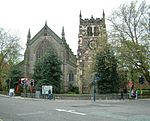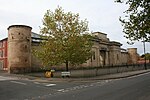Derby Blackfriars

Derby Black Friary, also known as Derby Dominican Priory, or Blackfriars, Derby, was a Dominican priory situated in the town of Derby, England. It was also named in different sources as a friary, monastery and convent, but was officially a priory as it was headed by a prior. The "Black" came from the colour of the mantles worn by the friars of the order. The friary was founded in the 13th century and enjoyed both royal patronage and royal visitors until its dissolution in 1539. It was constructed just outside the old town walls of Derby, on the site currently occupied by a house known as "The Friary" (formerly a hotel and currently a nightclub) on Friar Gate, just south of where Ford Street becomes Stafford Street. The priory was one of three in the immediate vicinity: a community of Benedictine nuns lived at The Priory of St Mary De Pratis (also known as King's Mead Priory), just under a quarter of a mile to the north-west; a community of Cluniac monks lived at St. James Priory (also known as Derby Cluniac Priory), just over a quarter of a mile to the south-east.
Excerpt from the Wikipedia article Derby Blackfriars (License: CC BY-SA 3.0, Authors, Images).Derby Blackfriars
Friar Gate, Derby New Normanton
Geographical coordinates (GPS) Address Phone number Website Nearby Places Show on map
Geographical coordinates (GPS)
| Latitude | Longitude |
|---|---|
| N 52.9232 ° | E -1.48383 ° |
Address
The Friary
Friar Gate
DE1 1FG Derby, New Normanton
England, United Kingdom
Open on Google Maps











